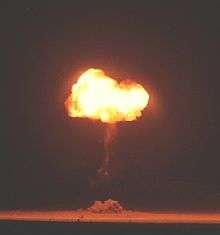Special Atomic Demolition Munition
.jpg)

The Special Atomic Demolition Munition (SADM) was a family of man-portable nuclear weapons fielded by the US military in the 1960s, but never used in combat. The US Army planned to use the weapons in Europe in the event of a Soviet invasion. US Army Engineers would use the weapon to destroy, irradiate and deny key routes of communication through limited terrain such as the Fulda Gap. Troops were trained to parachute into Soviet-occupied western Europe with the SADM and destroy power plants, bridges, and dams.
Coastal targets
It was also intended that the munition could be used against targets in coastal and near-coastal locations. One person carrying the weapon package would parachute from an aircraft and place the device in a harbor or other strategic location that was accessible from the sea. Another parachutist without a weapon package would follow the first to provide support as needed. The two-person team would place the weapon package in the target location, set the timer, and swim out into the ocean, where they would be retrieved by a submarine or a high-speed surface water craft.
Other lightweight nuclear devices
In the 1950s and 1960s, the United States developed several different types of lightweight nuclear device. The smallest of these was the W54 warhead, which had a 10.75 inches (273 mm) diameter, was about 15.7 inches (400 mm) long, and weighed approximately 23 kg (51 lb). It was fired by a mechanical timer and had a TNT equivalent between 10 tons and 1 kiloton. The W54 nuclear device was also used in the Davy Crockett Weapon System and in the GAR-11/AIM-26A.
Atomic demolitions munitions school
The Atomic Demolitions Munitions school was located at the US Army Engineer Center on Ft. Belvoir, Virginia, until it was closed in 1985.
See also
External links
| Wikimedia Commons has media related to Tactical nuclear weapons. |
- SADM Delivery by Parachutist/Swimmer (Special Atomic Demolition Munition) Film Clip (full film)
- image of the SADM
- ADM Web Page
